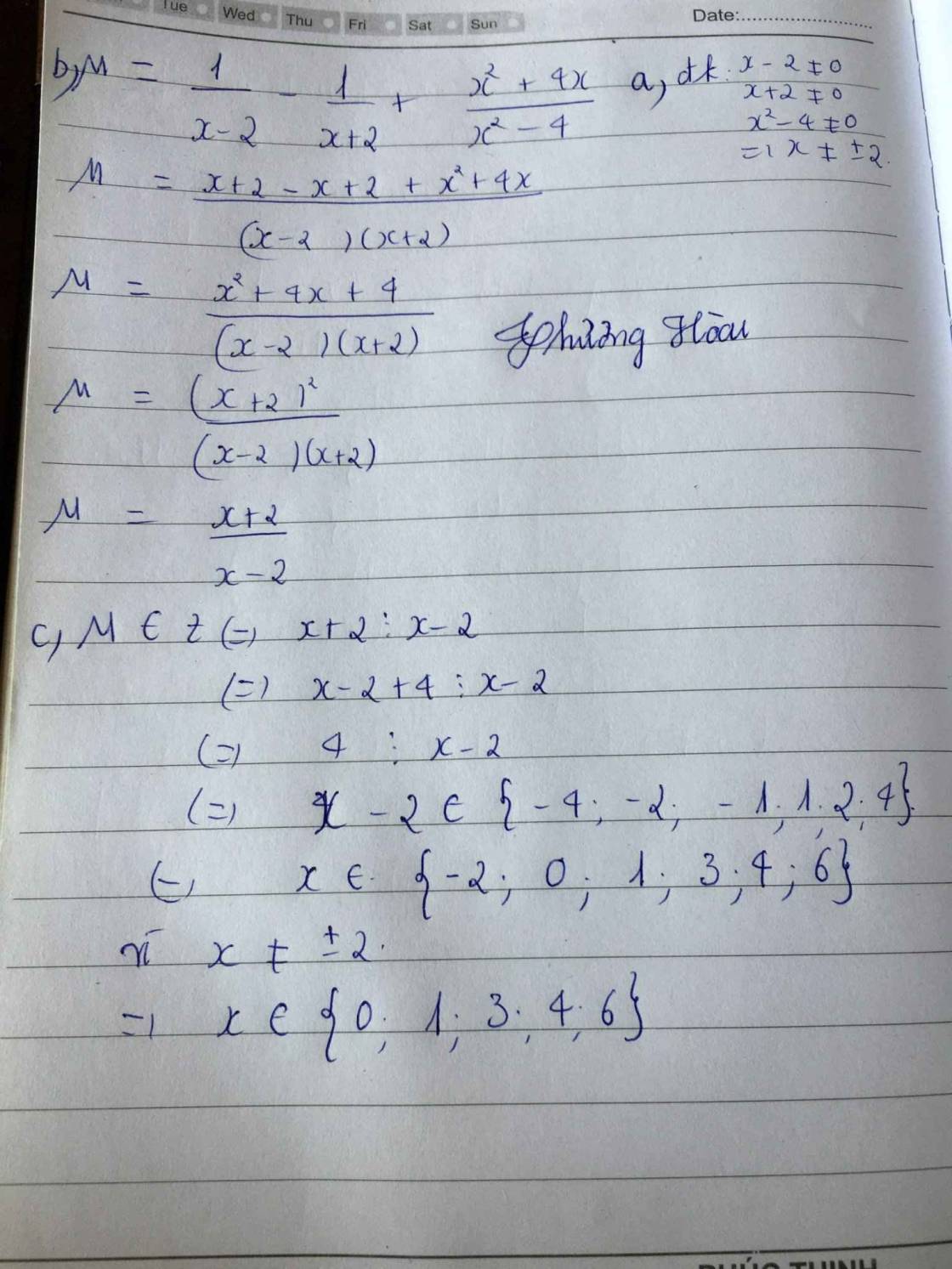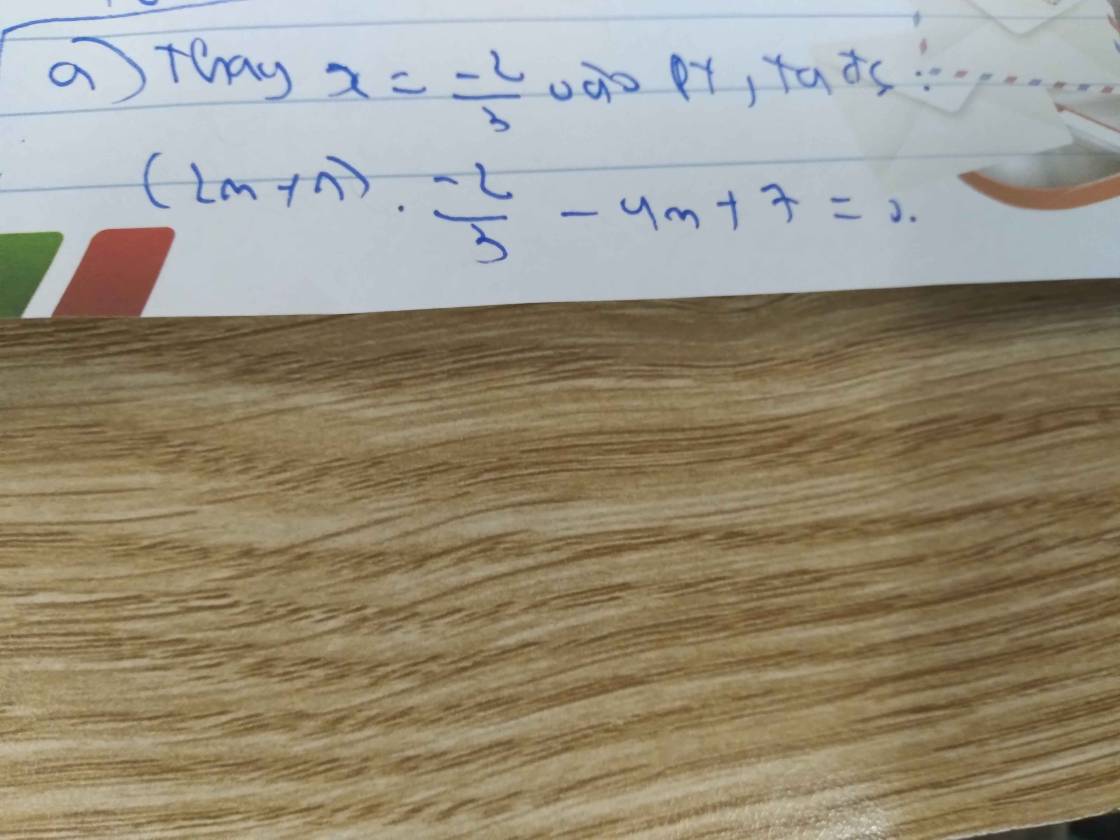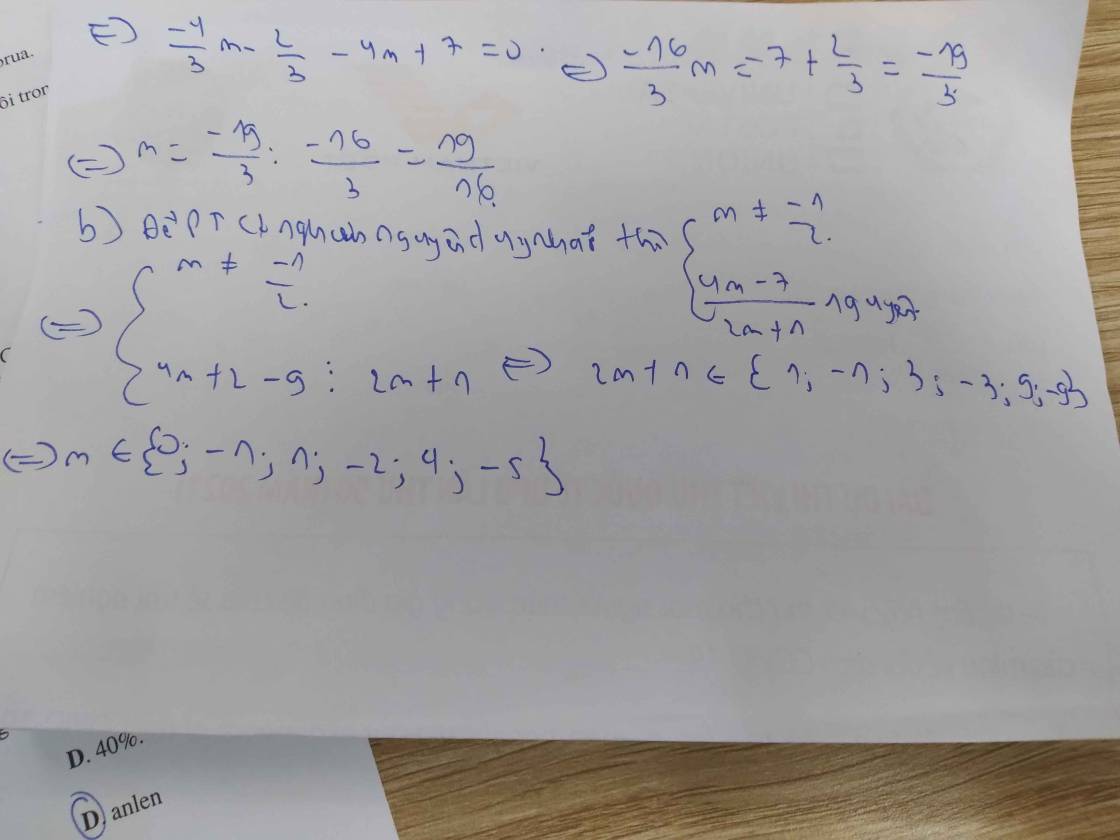
Hãy nhập câu hỏi của bạn vào đây, nếu là tài khoản VIP, bạn sẽ được ưu tiên trả lời.


a)
\(ĐKXĐ:\left\{{}\begin{matrix}x-2\ne0\\x+2\ne0\\x^2-4\ne0\end{matrix}\right.< =>\left\{{}\begin{matrix}x\ne2\\x\ne-2\end{matrix}\right.\)
b)
\(\dfrac{1}{x-2}-\dfrac{1}{x+2}+\dfrac{x^2+4x}{x^2-4}\)
\(=\dfrac{1}{x-2}-\dfrac{1}{x+2}+\dfrac{x\left(x+4\right)}{\left(x-2\right)\left(x+2\right)}\)
\(=\dfrac{x+2}{\left(x-2\right)\left(x+2\right)}-\dfrac{x-2}{\left(x-2\right)\left(x+2\right)}+\dfrac{x\left(x+4\right)}{\left(x-2\right)\left(x+2\right)}\)
\(=\dfrac{x+2-x+2+x^2+4x}{\left(x-2\right)\left(x+2\right)}\)
\(=\dfrac{x^2+4x+4}{\left(x-2\right)\left(x+2\right)}\\ =\dfrac{\left(x+2\right)^2}{\left(x-2\right)\left(x+2\right)}\\ =\dfrac{x+2}{x-2}\)
c)
\(\dfrac{x+2}{x-2}=\dfrac{x-2+4}{x-2}=\dfrac{x-2}{x-2}+\dfrac{4}{x-2}=1+\dfrac{4}{x-2}\)
vậy M nhận giá trị nguyên thì 4⋮x-2
=> x-2 thuộc ước của 4
\(Ư\left(4\right)\in\left\{-1;1;-2;2;;4;-4\right\}\)
ta có bảng sau
| x-2 | -1 | 1 | -2 | 2 | 4 | -4 |
| x | 1(tm) | 3(tm) | 0(tm) | 4(tm) | 6(tm | -2(loại) |

\(M=\frac{a^4-16}{a^4-4a^3+8a^2-16a+16}=\frac{\left(a^2-4\right)\left(a^2+4\right)}{a^4-4a^3+4a^2+4a^2-16a+16}=\frac{\left(a-2\right)\left(a+2\right)\left(a^2+4\right)}{a^2\left(a^2-4a+4\right)+4\left(a^2-4a+4\right)}\)
\(=\frac{\left(a-2\right)\left(a+2\right)\left(a^2+4\right)}{\left(a^2+4\right)\left(a-2\right)^2}=\frac{a+2}{a-2}=\frac{a-2+4}{a-2}=1+\frac{4}{a-2}\)
Để \(M\in Z\Leftrightarrow a-2\inƯ\left(4\right)=\left\{\pm1;\pm2;\pm4\right\}\)
Ta có bảng:
| a - 2 | 1 | -1 | 2 | -2 | 4 | -4 |
| a | 3 | 1 | 4 | 0 | 6 | -2 |
Vậy...

a)
Để A nguyên \(\Leftrightarrow x^3+x⋮x-1\)
\(\Leftrightarrow x^3-1+x+1⋮x-1\)
\(\Leftrightarrow\left(x-1\right)\left(x^2+x+1\right)+x+1⋮x-1\left(1\right)\)
Vì x nguyên \(\Rightarrow\hept{\begin{cases}x-1\in Z\\x^2+x+1\in Z\end{cases}}\)
\(\Rightarrow\left(x-1\right)\left(x^2+x+1\right)⋮x-1\left(2\right)\)
Từ (1) và (2) \(\Rightarrow x+1⋮x-1\)
\(\Leftrightarrow x-1+2⋮x-1\)
Mà \(x-1⋮x-1\)
\(\Rightarrow2⋮x-1\)
\(\Rightarrow x-1\inƯ\left(2\right)=\left\{\pm1;\pm2\right\}\)
\(\Rightarrow x\in\left\{-1;0;2;3\right\}\)
Vậy \(x\in\left\{-1;0;2;3\right\}\)
b) Để B nguyên \(\Leftrightarrow x^2-4x+5⋮2x-1\)
\(\Leftrightarrow2x^2-8x+10⋮2x-1\)
\(\Leftrightarrow\left(2x^2-x\right)-\left(6x-3\right)-\left(x-7\right)⋮2x-1\)
\(\Leftrightarrow x\left(2x-1\right)-3\left(2x-1\right)-\left(x-7\right)⋮2x-1\)
\(\Leftrightarrow\left(2x-1\right)\left(x-3\right)-\left(x-7\right)⋮2x-1\left(1\right)\)
Vì x nguyên \(\Rightarrow\hept{\begin{cases}2x-1\in Z\\x-3\in Z\end{cases}}\)
\(\Rightarrow\left(2x-1\right)\left(x-3\right)⋮2x-1\left(2\right)\)
Từ (1) và(2) \(\Rightarrow x-7⋮2x-1\)
\(\Leftrightarrow2x-14⋮2x-1\)
\(\Leftrightarrow2x-1-13⋮2x-1\)
Mà \(2x-1⋮2x-1\)
\(\Rightarrow13⋮2x-1\)
\(\Rightarrow2x-1\inƯ\left(13\right)=\left\{\pm1;\pm13\right\}\)
Làm nốt nha các phần còn lại bạn cứ dựa bài mình mà làm

a ) ĐKXĐ : \(x\ne\pm2\)
Ta có : \(M=\frac{1}{x-2}-\frac{1}{x+2}+\frac{x^2+4x}{x^2-4}\)
\(=\frac{x+2}{\left(x-2\right)\left(x+2\right)}-\frac{x-2}{\left(x-2\right)\left(x+2\right)}+\frac{x^2+4x}{\left(x-2\right)\left(x+2\right)}\)
\(=\frac{x+2-x+2+x^2+4x}{\left(x-2\right)\left(x+2\right)}\)
\(=\frac{x^2+4x+4}{\left(x-2\right)\left(x+2\right)}\)
\(=\frac{\left(x+2\right)^2}{\left(x-2\right)\left(x+2\right)}\)
\(=\frac{x+2}{x-2}\)
b ) Để \(M\in Z\Leftrightarrow\frac{x+2}{x-2}\in Z\Leftrightarrow x+2⋮x-2\)
\(\Leftrightarrow x-2+4⋮x-2\)
\(\Leftrightarrow4⋮x-2\)
\(\Leftrightarrow x-2\in\left\{1;-1;2;-2;4;-4\right\}\left(x\in Z\Rightarrow x-2\in Z\right)\)
\(\Leftrightarrow x\in\left\{3;1;4;0;6;-2\right\}\)
Vậy \(M\in Z\Leftrightarrow x\in\left\{3;1;4;0;6;-2\right\}\)
:D

a. M=\(\frac{1}{x-2}-\frac{1}{x+2}+\frac{x^2+4x}{x^2-4}\)
\(M=\frac{1}{x-2}-\frac{1}{x+2}+\frac{x^2+4x}{\left(x-2\right)\left(x+2\right)}\) MC = (x-2)(x+2)
\(M=\frac{x+2}{\left(x-2\right)\left(x+2\right)}-\frac{x-2}{\left(x+2\right)\left(x-2\right)}+\frac{x^2+4x}{\left(x-2\right)\left(x+2\right)}\)
\(M=\frac{x+2-x+2+x^2+4x}{\left(x-2\right)\left(x+2\right)}\)
\(M=\frac{x^2+4x+4}{\left(x-2\right)\left(x+2\right)}\)
\(M=\frac{\left(x+2\right)^2}{\left(x-2\right)\left(x+2\right)}\)
\(M=\frac{x+2}{x-2}\)
b. Ta có: \(M=\frac{x+2}{x-2}=\frac{x-2+2+2}{x-2}=\frac{x-2+4}{x-2}=\frac{x-2}{x-2}+\frac{4}{x-2}=1+\frac{4}{x-2}\)
Để M đạt giá trị nguyên thì \(\frac{4}{x-2}\) cũng phải đạt giá trị nguyên
\(\Leftrightarrow\left(x-2\right)\inƯ\left(4\right)=\left\{1;-1;2;-2;4;-4\right\}\)
\(\Leftrightarrow x=\left\{3;1;4;0;6;-2\right\}\)
a) \(M=\frac{1}{x-2}-\frac{1}{x+2}+\frac{x^2+4x}{\left(x+2\right)\left(x-2\right)}\)
\(\Rightarrow M=\frac{x+2-\left(x-2\right)+x^2+4x}{\left(x+2\right)\left(x-2\right)}\)
\(\Rightarrow M=\frac{x+2-x+2+x^2+4x}{\left(x+2\right)\left(x-2\right)}\)
\(\Rightarrow M=\frac{x^2+4x+4}{\left(x+2\right)\left(x-2\right)}=\frac{\left(x+2\right)^2}{\left(x+2\right)\left(x-2\right)}=\frac{x+2}{x-2}\)
b) \(\frac{x+2}{x-2}=\frac{x-2+4}{x-2}=\frac{x-2}{x-2}+\frac{4}{x-2}=1+\frac{4}{x-2}\)
\(\Rightarrow x-2\inƯ_4\left\{-4;-2;-1;1;2;4\right\}\)
Ta có :
\(x-2=-4\Rightarrow x=-2\) (loại)
\(x-2=-2\Rightarrow x=0\)
\(x-2=-1\Rightarrow x=1\)
\(x-2=1\Rightarrow x=3\)
\(x-2=2\Rightarrow x=4\)
\(x-2=4\Rightarrow x=6\)
Vậy: Các giá trị của x để \(M\in Z\) là:
\(x=0;1;3;4;6\)

a: \(M=\dfrac{1-x}{1+x}:\dfrac{x^2-9-x^2+4+x+2}{\left(x-3\right)\left(x-2\right)}\)
\(=\dfrac{1-x}{1+x}\cdot\dfrac{\left(x-3\right)\left(x-2\right)}{x-3}=\dfrac{\left(1-x\right)\left(x-2\right)}{\left(1+x\right)}\)
b: M<0
=>(x-1)(x-2)/(x+1)>0
=>-1<x<1 hoặc x>2
c: M nguyên
=>(x-1)(x-2) chia hết cho x+1
=>x^2-3x+2 chia hết cho x+1
=>x^2+x-4x-4+6 chia hết cho x+1
=>x+1 thuộc {1;-1;2;-2;3;-3;6;-6}
=>x thuộc {0;-2;1;-3;-4;7;-5}

\(A=\frac{2m-7}{m+1}=\frac{2m+2-9}{m+1}=\frac{2\left(m+1\right)-9}{m+1}=2-\frac{9}{m+1}\)
Để \(2-\frac{9}{m+1}\) là số nguyên <=> \(\frac{9}{m+1}\) là Số nguyên
=> m + 1 ∈ Ư(9) = { ± 1; ± 3; ± 9 }
| m + 1 | - 9 | - 3 | - 1 | 1 | 3 | 9 |
| m | - 10 | - 4 | - 2 | 0 | 2 | 8 |
Vậy m ∈ { - 10 ; - 4 ; - 2 ; 0 ; 2 ; 8 }
Để A nguyên <=> \(\frac{2m-7}{m+1}\in Z\Leftrightarrow\frac{2\left(m+1\right)-9}{m+1}=2-\frac{9}{m+1}\in Z\Leftrightarrow\frac{9}{m+1}\in Z\)
Hay m+1 là U(9)
Ta có bảng sau:
| m+1 | -9 | -3 | -1 | 1 | 3 | 9 |
| m | -10 | -4 | -2 | 0 | 2 | 8 |
Vậy m=...



Để \(A=\frac{4}{m+1}\in Z\)
\(\Rightarrow4⋮m+1\)
=> m + 1 thuộc Ư(4) = {1 ; -1 ; 2 ; -2 ; 4 ; -4}
Ta có bảng sau :
Để 4(m + 1) là số nguyên <=> m + 1 thuộc Ư(4) = { - 4; - 2; - 1; 1; 2; 4 }
=> m + 1 = { - 4; - 2; - 1; 1; 2; 4 }
=> m = { - 5; - 3 ; - 2 ; 0 ; 1 ; 3 }
Vậy m = { - 5; - 3 ; - 2 ; 0 ; 1 ; 3 }